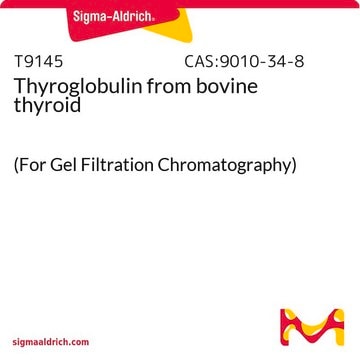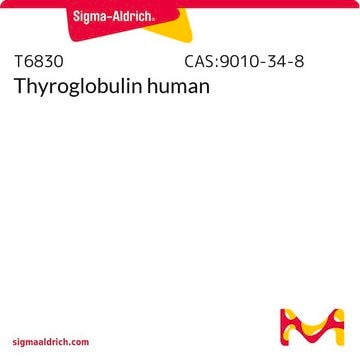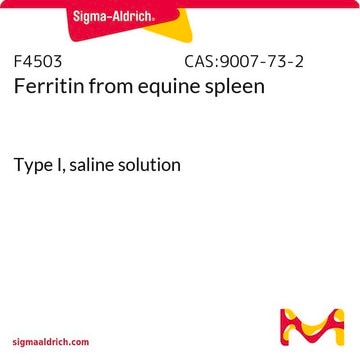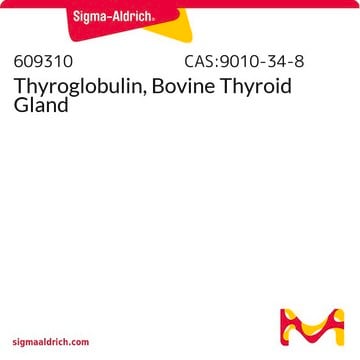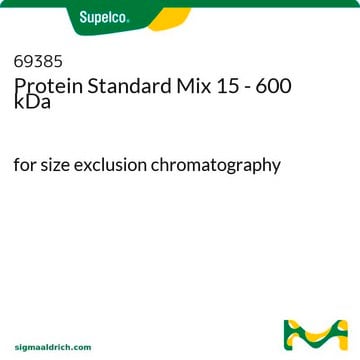T1001
Thyroglobulin from bovine thyroid
powder, ≥90% (agarose gel electrophoresis)
Synonym(s):
Globulins thyro, Thyractin
Sign Into View Organizational & Contract Pricing
All Photos(4)
About This Item
Recommended Products
biological source
bovine thyroid
Assay
≥90% (agarose gel electrophoresis)
form
powder
mol wt
~670 kDa
composition
Iodine, ≥0.20%
nitrogen analysis
13.0-16.0% total
ash
≤4%
solubility
H2O: 20 mg/mL
UniProt accession no.
storage temp.
−20°C
Gene Information
cow ... TG(280706)
Looking for similar products? Visit Product Comparison Guide
Application
Bovine thyroglobulin was shown to stimulate proliferation in rat thyroid follicular cells as well as in primary porcine thyroid epithelial cells. This effect was mediated through PI3K signaling.
Often used as a carrier protein for the production of antibodies. Its advantage is the large number of tyrosine residues that can be used for conjugation using the diazo reaction.
Biochem/physiol Actions
Bovine thyroglobulin is a large, tetrameric glycoprotein produced in the thyroid gland as a precursor to thyroid hormones. Its large size and absence from plasma under normal conditions makes it very immunogenic and reduces the chance that antibodies to this carrier protein will cross-react with plasma proteins in immunoassays. Haptens may be conjugated to thyroglobulin via accessible secondary amines.
Iodine-containing protein that is stored in the thyroid gland. Converted into circulating thyroxines when the thyroid is stimulated by thyroid-stimulating hormone (TSH) from the pituitary. Because its expression is unique to the thyroid, it is a sensitive indicator of recurrence or metastasis of thyroid cancer that has been treated by thyroid ablation.
Storage Class Code
11 - Combustible Solids
WGK
WGK 3
Flash Point(F)
Not applicable
Flash Point(C)
Not applicable
Personal Protective Equipment
dust mask type N95 (US), Eyeshields, Gloves
Certificates of Analysis (COA)
Search for Certificates of Analysis (COA) by entering the products Lot/Batch Number. Lot and Batch Numbers can be found on a product’s label following the words ‘Lot’ or ‘Batch’.
Already Own This Product?
Find documentation for the products that you have recently purchased in the Document Library.
Customers Also Viewed
Laura Gámez-Díaz et al.
Immunology and cell biology, 95(9), 789-802 (2017-06-28)
Biallelic mutations in the human lipopolysaccharide responsive beige-like anchor (LRBA) gene lead to a primary immunodeficiency known as LRBA deficiency, characterized by a broad range of clinical manifestations including autoimmunity, organomegaly, hypogammaglobulinemia and recurrent infections. Considering the phenotypic heterogeneity in
N Murat Karabacak et al.
Molecular & cellular proteomics : MCP, 8(4), 846-856 (2008-12-17)
Top-down and bottom-up mass spectrometry methods can generate gas phase fragments and use these to identify proteins. Top-down methods, in addition, can provide the mass of the protein itself and therefore additional structural information. Despite the conceptual advantage of top-down
Mahsa Hadidi et al.
Biotechnology progress, 32(6), 1531-1538 (2016-10-22)
Charged polysaccharides are used in the food industry, as cosmetics, and as vaccines. The viscosity, thermodynamics, and hydrodynamic properties of these charged polysaccharides are known to be strongly dependent on the solution ionic strength because of both inter- and intramolecular
William H Fissell et al.
Journal of membrane science, 326(1), 58-63 (2010-01-08)
Silicon micromachining provides the precise control of nanoscale features that can be fundamentally enabling for miniaturized, implantable medical devices. Concerns have been raised regarding blood biocompatibility of silicon-based materials and their application to hemodialysis and hemofiltration. A high-performance ultrathin hemofiltration
Jonathan Friedman et al.
Nature ecology & evolution, 1(5), 109-109 (2017-08-16)
Microorganisms typically form diverse communities of interacting species, whose activities have tremendous impact on the plants, animals and humans they associate with. The ability to predict the structure of these complex communities is crucial to understanding and managing them. Here
Our team of scientists has experience in all areas of research including Life Science, Material Science, Chemical Synthesis, Chromatography, Analytical and many others.
Contact Technical Service